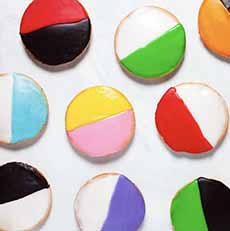Black And White Cookie History For National Black & White Cookie Day
|
|
Oh, what a great reason to eat black and white cookies: September 14th is National Black And White Cookie Day. One of our favorite cookies since childhood, these large cake-like cookies are iced, half in vanilla fondant or boiled icing, half in chocolate icing. Today, most bakers use boiled icing; it’s easier and less expensive than fondant. Because some of the cookie’s fans preferred one side of icing more than the other, some bakers make all-chocolate or all-vanilla-iced cookies in addition to the black-and-white. We call them “full moon cookies” (you heard it here first). A good black-and-white cookie is fresh, so that the yellow cake is not hard* (it dries out easily). A tip: If you’re buying them in a store where you help yourself, to place a finger on the underside and press. It should be springy. The cake is made with vanilla extract and ideally, a teeny hint of almond extract in it. The icing has just enough sugar, not too much. Pursuant to the ideal of soft cake, black-and-whites are actually neither cookie nor cake, but a hybrid. They are a drop cake†, which adds extra flour to cupcake batter so the batter can be dropped on a baking sheet without running. Like cookies, they are finger food. Unlike cookies, which are hard and can be stored at room temperature two to three weeks (2 months in the fridge, 8-12 months in the freezer), they need to be consumed within a day. Black-and-whites are also called half moon cookies, a term you’ll see more of in the cookie’s history below. A black-and-white isn’t always iced with chocolate and vanilla. Sometimes colored icing is substituted for the chocolate; for example, pink and white icing for Valentine’s Day (photo #4), green and white icing for St. Patrick’s Day, blue and white icing for Chanukah. For Halloween, bakers often do white and orange, or chocolate and orange (photo #5); and similarly, with red and green for Christmas. Sometimes the colors are replaced entirely, e.g. with team colors or wedding colors (photo #6). The earliest printed reference we’ve found is a testimony from a third-generation baker at Glaser’s Bakery on the Upper East Side, who noted that the bakery had made black-and-white cookies since it opened in 1902 (source). Glaser’s black-and-whites were the dry cake variety, with thick layers of fluffy frosting instead of the fondant-like icing. Is it possible that the bakery founder, a Bavarian immigrant named John Herbert Glaser, brought the idea with him from Germany? Well…in Germany, black-and-white cookies are called Amerikaner (American) cookies [source]. So how did Amerikaners get to Germany? According to one source: (Alas, Glaser’s Bakery, long an institution on the Upper East Side of Manhattan, closed its doors after 116 years (on July 1, 2018). The third generation baker, Herb Glaser, was ready to retire.) The half moons look just like black-and-white. In our youth, black-and-whites were also called half moon cookies. The first print reference we found to a half moon cookiecites Hemstrought’s Bakery in Utica, New York, which started baking half-moons around 1925. Did someone see thee black-and-white in New York City and bring the idea to Utica, some 240 miles away? Possibly? Probably? *You may see the cake referred to as dry-style. This means a tight crumb, with extra flour added—not hard cake. †A drop cake is an old term for a small cake made by dropping thick batter from a spoon into hot, deep fat; or baked in the oven on a well-buttered pan. Here’s a recipe for a deep fat fried drop cake. |
|
|
|
||





